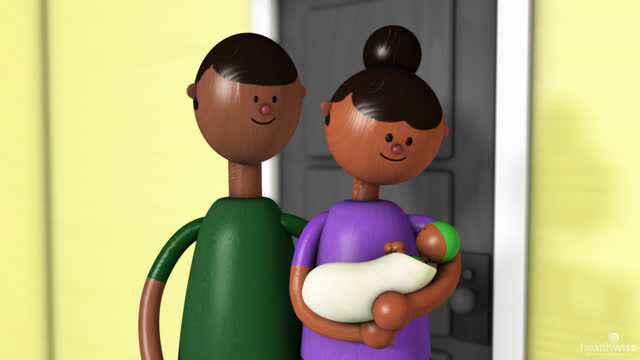Baby’s Daily Needs: What to Expect
Topic Overview
To help establish and maintain a predictable daily schedule, respond to your baby’s needs and try to reinforce your baby’s natural habits.
Eating
From birth, babies follow their internal hunger and fullness cues. They eat when they’re hungry and stop eating when they’re full. Experts agree that newborns should be fed on demand. This means that you bottle- or breastfeed your infant whenever he or she shows signs of hunger, rather than setting a strict schedule.
How often your baby needs to eat will depend on your baby’s age and how hungry he or she is at that moment. As your newborn grows, you can try these tips:
- At about 3 weeks, you can try delaying feeding for a short time by cuddling or talking with your newborn. Your newborn’s nervous system is mature enough that he or she can wait longer between feedings and interact with you more at this age. Take cues from your baby. Don’t force your baby to engage with you when he or she is not responding and appears to be very hungry.
- You might be able to limit nighttime feedings if you avoid socializing with your baby and lingering after he or she has finished eating. As your baby wakes up for the next feeding, try to respond before he or she starts to cry a lot. During the feeding, keep the light off and use a soft voice. Your baby will feed and go back to sleep easier if he or she is calm. If you find that you want to give your baby more attention during nighttime feedings, plan for a time you can rest the following day to avoid fatigue. By age 2 months, many babies begin eating less frequently at night.
At age 3 to 4 months, babies become more and more interested in the world around them. Babies often interrupt feedings by looking around, smiling, cooing, and reaching for a parent’s face. This is a normal attempt to turn feeding times into a more social event and an opportune time for parents to interact with their babies.
At about 6 months, most babies can start to eat solid foods. Some babies may be ready for solid foods at 4 or 5 months. Ask your doctor when you can start feeding your baby solid foods. This complements breast milk or formula. Try to be patient as your baby experiments and learns new eating skills like chewing and using cups and utensils.
For more information about feeding, see the topics Breastfeeding, Bottle-Feeding, and Weaning. Follow your doctor’s advice on when and what to feed your baby.
Diaper changes
You may be surprised at the number of diapers your newborn goes through every day. It’s important to change your baby’s diaper, because urine and stool can irritate your baby’s skin.
Paying attention to your newborn’s wet and soiled diapers can also give you clues about your baby’s health.
The number of diapers a newborn wets is sometimes hard to know, because disposable diapers work so well to wick moisture. In general, though, your newborn should have about 3 wet diapers a day for the first few days. After that, your baby should have at least 6 wet diapers a day throughout the first month of life. The urine should be yellow in color. Don’t be alarmed, though, if you notice a pink color to the urine during your newborn’s first 3 days of life. It is common for newborns to pass crystals in the urine (highly concentrated urine) which makes the urine look pink. If the pink color lasts, or if at any time your baby seems to be in pain while urinating, call your doctor.
Your newborn’s stools usually will change from black to green in the first few days. Then they will change to yellow or yellowish brown by the end of the first week. Breastfed babies typically have more yellowish stools than formula-fed babies. They also tend to have stools more often. Many newborns have at least 1 or 2 bowel movements a day. By the end of the first week, your baby may have as many as 5 to 10 a day. For more information about stools and when to call the doctor, see Bowel Movements in Babies.
Call your doctor if your baby does not regularly produce wet or soiled diapers.
Sleeping
A newborn moves between sleeping and waking during a 24-hour day. Most newborns sleep for a total of 18 hours each day, waking for short periods at least every 2 to 3 hours. When your newborn wakes up, he or she will usually be hungry and need to be fed. This pattern dominates your baby’s first few weeks.
Sleeping patterns vary with each child and gradually evolve over the first year. Sleep habits are influenced by the baby’s temperament and feeling of being well fed and the parents’ response to waking episodes. Some babies naturally seem to need more sleep than others.
Periods of murmuring and restlessness every 50 to 60 minutes are a normal part of the baby sleep cycle. These periods are known as “active sleep.” The restlessness usually lasts a few minutes, and if babies are left alone, they usually fall back to sleep.
The sleep cycles include:
- Drowsy sleep. The baby moves little but may be wakened easily. His or her eyes may start to close or gently open. Drowsy sleep can occur at the start or end of the sleep cycle.
- Quiet, or deep, sleep. The baby moves very little; has deep, regular breathing; and has no noticeable eye movement under the eyelids. The baby is not wakened easily.
- Active, or light, sleep. The baby appears restless and breathes quickly and irregularly. Eye movement is noticeable under the eyelids. A 1-month-old may spend about 50% of his or her sleep time in active sleep, while older children and adults spend about 20%. It is believed that a baby has longer periods of active sleep than an adult because the brain is developing rapidly.
At first, babies often sleep through loud noises. But at about 3 to 4 months of age many babies become easily disturbed by noises like the phone ringing or a dog barking.
During a baby’s first few months, maturing of the brain allows the baby gradually to sleep for longer periods. By age 3 months, most babies sleep for their longest period (up to 7 to 8 hours) during the night and develop set nap times. They are also more alert when awake and you can gradually add time between feedings. At about 3 to 4 months, start bedtime rituals to help your baby relax. Read a story, play quiet music, sing, rock your baby, or give him or her a gentle massage. Avoid loud music or sounds and bright lights.
Sleep patterns often change during the second half of the first year. By 9 months of age and into the second year of life, it can be hard for some babies to let go of the excitement of the day. Also at this age, many babies want to exert control over their actions. Because of these things, your baby may resist going to sleep at the times you want. To promote a regular schedule, stay with your routines when your baby resists going down for a nap or going to bed at the usual time.
Naps
Somewhere between 12 and 24 months of age, your toddler will likely resist a morning nap and want to rest only in the afternoon. Your child’s attempt to switch to one nap a day often occurs at about 18 months of age. Many doctors recommend keeping both naps as long as possible for both the child’s and the parents’ benefit.
When your child resists taking a nap, you can try blocking out time in the afternoon for a quiet period. Even if your child doesn’t sleep, he or she usually still needs a restful break.
A toddler’s excitement about learning to walk and about his or her emerging independence can sometimes also disrupt afternoon nap schedules. Toddlers often are more eager to practice new skills than to sleep. You may want to try some of the following tips to help your child get needed rest:
- Have your child nap in the same place that he or she sleeps at night, if possible.
- Tell your child when nap time is approaching, such as by saying “10 more minutes and it’s time to lie down.”
- Slow down the pace as nap time nears. Play quietly, read books, or initiate other soothing activities.
- Time naps so they don’t extend past 3 or 4 in the afternoon, or you may have a harder time putting your child to bed at night.
- Make sure the napping room is quiet and dark. Try playing soft music, running a fan, or providing other soothing sounds.
Current as of: December 12, 2018
Author: Healthwise Staff
Medical Review:Susan C. Kim, MD – Pediatrics & Kathleen Romito, MD – Family Medicine & John Pope, MD, MPH – Pediatrics
This information does not replace the advice of a doctor. Healthwise, Incorporated, disclaims any warranty or liability for your use of this information. Your use of this information means that you agree to the Terms of Use. Learn how we develop our content.






